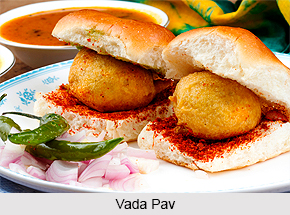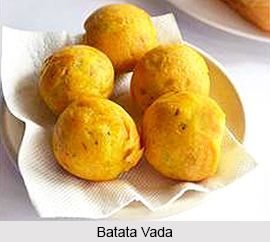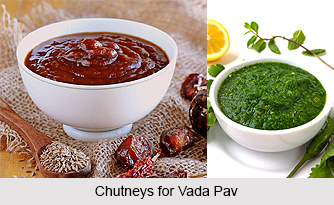 Vada Pav is one of the most humble and famous street foods of Mumbai. It is the common man"s food in Mumbai and is a popular street food snack across whole Maharashtra. It is a vegetarian fast food dish native to the Indian state of Maharashtra. It originated as cheap street food in Mumbai, but is now offered in stalls and restaurants throughout India. It is a tasty and delicious snack which is an Indianised version of Burger.
Vada Pav is one of the most humble and famous street foods of Mumbai. It is the common man"s food in Mumbai and is a popular street food snack across whole Maharashtra. It is a vegetarian fast food dish native to the Indian state of Maharashtra. It originated as cheap street food in Mumbai, but is now offered in stalls and restaurants throughout India. It is a tasty and delicious snack which is an Indianised version of Burger.
Vada Pav basically has a Batata Vada or Potato Fritter which is sandwiched between two slices of a pav, along with sweet chutney and green chutney. It is easy to make and serve. Pav means a small loaf of bread. Pav is easily available in most bakeries, super stores and sweet shops in Maharashtra. The vada pav can be had during any time of day like breakfast, brunch or as an evening snack. Vada pav goes very well with the Masala Chai and usually fried green chilies and chutney are served along with it.
History of Vada Pav
Vada Pav is believed to have been created by Ashok Vaidya who sold street food from a stall beside Dadar Rail Station in Mumbai in 1971. It is now offered at street stalls, cafes and restaurants throughout India.
 Ingredients of Vada Pav
Ingredients of Vada Pav
•8 Pav
•Dry Garlic Chutney
•Mint and Coriander Chutney
•Sweet Tamarind Chutney
•1 and 1/2 cups boiled and mashed potatoes
•2 green chillies, chopped
•1 and 1/2 tbsp grated garlic
•1 tsp mustard seeds
•1/4 tsp asafoetida
•6 to 8 curry leaves
•1 tbsp turmeric powder
•2 tbsp oil
•3/4 cup besan
•A pinch of baking soda
•Salt to taste
Method to Prepare Vada Pav
•Pound the green chillies, ginger and garlic using a mortar and pestle.
•Heat the oil and add the mustard seeds. When they crackle, add the asafoetida and curry leaves and sauté for a few seconds.
•Add the pounded mixture and saute again for a few seconds.
•Add the potatoes, turmeric powder and salt and mix well.
•Remove from the fire and cool.
•Divide into 8 equal portions. Shape into rounds.

•Combine besan, turmeric powder and baking soda in a bowl and make a batter using approximately 1/3 cup of water.
•Dip each round of the vada filling into the batter and allow it to coat the mixture well.
•Deep fry in hot oil till golden brown. Drain on absorbent paper and keep aside.
•Slice each pav into half and spread green chutney and tamarind chutney on each halves.
•Sprinkle some dry garlic chutney inside.
•Place one vada in each pav and serve immediately with fried green chillies.




















